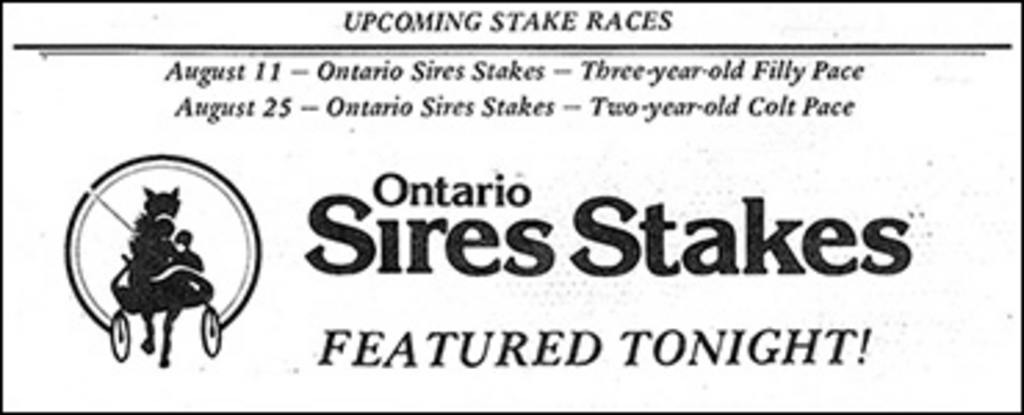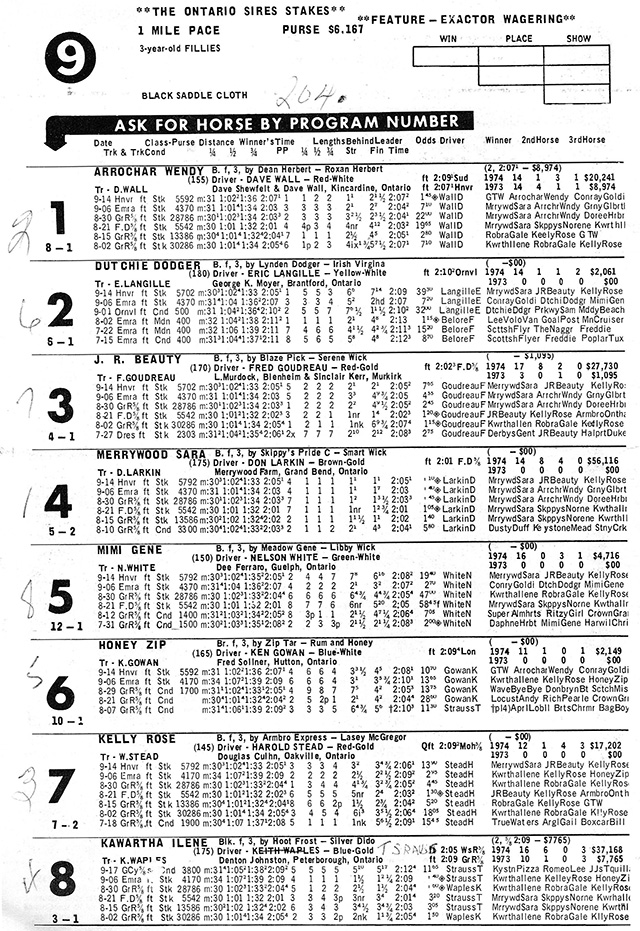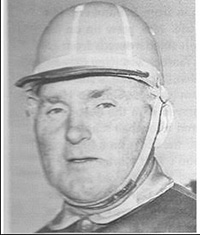
In this week's Rewind Robert Smith presents the second edition of an ongoing series recalling the start up and some first year highlights of the Ontario Sires Stakes program that started back in 1974. Further stories recalling the O.S.S. will appear in future Rewinds.
In January of this year, an edition of Rewind chronicled the formation, introduction and actual start up of the Ontario Sires Stakes program. Now into its 43rd consecutive year of existence, it is the model of a highly successful program intended to promote and enhance the sport in a multitude of directions. Despite the woes the industry has experienced in recent times, the O.S.S. has survived and continues to provide a great opportunity for Ontario-bred horses.
Dating back to June 1, 1974 the date of the very first contesting of an O.S.S. event, this series has generated a great deal of interest in both racing and breeding circles. For quite some time many people in the industry were convinced that the future success of Standardbred breeding in Ontario hinged on the creation of a major Sires Stakes program. The one already in existence in New York State was considered to be the best. When the Ontario program was announced in 1973, the average yearling price at that fall's sales doubled.
As I recall virtually everyone in the industry was excited and interested, with each party seeking their best path whether their interest was in the breeding or racing end of things. New stallions were brought into Canada and the demand for Ontario-sired colts or fillies escalated sharply. As expected, the program brought in a number of top formerly American-based sires to stand at Ontario farms for the 1975 breeding season.
Immediately the new O.S.S. program became a significant success. Whether races were held at major Raceways or at smaller "B" Track venues, the crowds were much larger than for other racing. Through the racetrack's tax sharing arrangement, the Province of Ontario contributed $1,212,396 which formed the base on which the O.S.S. was built. The balance of the funding came from the various race associations and the horsemen's nominating, starting and sustaining payments. In simple terms, the racing of two- and three-year-olds became much more lucrative.
In all during that first year, there were 24 O.S.S. events held at the six major Raceways which then included Greenwood, Mohawk, Garden City, London, Rideau Carleton and Windsor Raceway. At the smaller "B" class tracks, 56 events were held. At the "A" tracks most races went for $50,000, and at the "B" tracks a basic $9,000 was the purse. In cases where an abundance of starters was experienced, a rare split was made.
After the final event of the 80-race schedule at 20 different Provincial Tracks in 1974, the purse total of $1,853,818 outstripped the first estimates which the architects of the program had pegged at $1.7 million. Fueled by the first year's success, the sale price of Ontario-sired yearlings showed a marked increase in the fall of 1974 as a result of their eligibility to the 1975 O.S.S. events. Because of increased betting at all Ontario harness raceways, the second year program was already estimated to be worth $2.3 million.
From an ownership standpoint the program was designed to be wide open. The only stipulation was that the individual horse racing in the O.S.S. events had to be sired by an Ontario-based stallion, registered with the Sires Stakes program. This resulted in a number of stallioneers at various Ontario farms reporting broodmare bookings from as far away as California, Illinois and Kentucky. Understandably a greater number of bookings came from mare owners living in the neighbouring provinces of Quebec and Manitoba, and closer states such as Michigan, Ohio and Pennsylvania.
By late 1973, breeding farms began to advertise that foals sired by registered stallions would be immediately eligible for the rich O.S.S. events.
Highlights Of The First Year
Several outstanding performers quickly emerged in O.S.S. action and most were the property of what might be termed 'smaller' operations. Eric McIlroy's Merrywood Farm, located at Grand Bend, sent out Merrywood Sara, a daughter of Skippys Pride C. out of Smart Wick. Trained and driven throughout her sophomore campaign by Don Larkin, this superb filly was almost unbeatable during that season. She paced the season's fastest miles on both half-mile and five-eighths tracks. Her record setting miles were 2:01 at Frontenac Downs in Kingston (5/8) and a blazing 2:03 over the little Elmira Raceway half-miler. Next in earnings with $49,069 was Kawartha Ilene, owned by Denton Johnson of Peterborough, Ont. and racing out of the large Keith Waples stable, at times driven by Tom Strauss.

A copy of an early Ontario Sires Stakes event held at the newly opened Barrie Raceway on the evening of September 23, 1974. The two top money winners in the three-year-old pacing division were both in this race. It is interesting to note that each of the eight starters were by a different Ontario sire. Also despite the passage of 42 years I believe six of the eight drivers in the race are still with us; a number still actively involved in the sport.
While the O.S.S. program was designed solely for young up and coming horses and included many young drivers, it also attracted some older competitors. During that first year one of the most successful reinsmen was 68-year-old Harold Wellwood Sr. of Stratford Ont., who campaigned the overall top money winner in the entire program -- three-year-old Terry Parker -- and also a top two-year-old Pats, Bye Bye. Both colts were owned by Clint Hodgins, then of Orlando, Florida but originally an Ontario native. It was a bit like turning the clock back as these two wily veterans had started their careers at some of the very tracks that were now hosting Sires Stakes events.
 Harold (at right) showed the younger set that he still knew the way to the winner's circle and appeared there with regularity. I recall making my first visit ever to see O.S.S. action that year when the two-year-old colt pacers came to Canada's most southerly track, Leamington Raceway. It was an opportunity to see first hand the new program and also a chance to visit with my all-time favourite horseman. Harold was then obviously in the twilight of his driving career but within a couple of years (1977) he would also be part of O.S.S. history when a colt that he bred, raised and trained would become the first horse to crack the elusive 2:00 barrier. That story will appear in a future Rewind.
Harold (at right) showed the younger set that he still knew the way to the winner's circle and appeared there with regularity. I recall making my first visit ever to see O.S.S. action that year when the two-year-old colt pacers came to Canada's most southerly track, Leamington Raceway. It was an opportunity to see first hand the new program and also a chance to visit with my all-time favourite horseman. Harold was then obviously in the twilight of his driving career but within a couple of years (1977) he would also be part of O.S.S. history when a colt that he bred, raised and trained would become the first horse to crack the elusive 2:00 barrier. That story will appear in a future Rewind.
Undoubtedly the success story of the entire first year was the accomplishments of Shawland Belle, a two-year-old trotting daughter of Hoot Frost. This stallion (Hoot Frost) formerly stood at the Armstrong Farm in Brampton but was later leased to a breeder in P.E.I. Shawland Belle won an incredible $62,504 in O.S.S. action and was narrowly edged out as top earner when Terry Parker banked $63,871 to lead all competitors regardless of gait, gender or age.
Shawland Belle's owner and breeder, James N. Shaw of Ancaster, Ont., had purchased the filly's unraced dam Hoot And Scoot for a mere $700 and decided to breed her to Hoot Frost resulting in this filly. The tale was told that Shaw tried very hard to sell the filly prior to her 1974 campaign but thankfully he stated later didn't find a buyer. She set the standard for freshman fillies as she trotted identical marks of 2:09.3 on both half and five eighths tracks for veteran driver Don Davies. That along with her over $62,000 in season's earnings made her quite an investment despite the fact that it was not exactly planned that way.
Another member of the 'Class of '74' that turned in a stellar season was Garma Hooligan, who led the three-year-old trotting colts and geldings with earnings of
$58,782 and was handled by Brent Davies, son of the aforementioned Don Davies. The figures recorded by the more successful competitors represented some sizable earnings when you consider that a figure of $50,000 back in 1974 is worth approximately $244,000 in today's currency when adjusted for inflation.
From a non-statistical standpoint, one first year competitor became an instant hit with the fans and to this day remains in the memory of many who date back that far. A three-year-old pacing gelding named Paulas Peanut, owned by a very young Miss Paula Wellwood, not only performed admirably on the track but also gained a host of fans wherever he appeared that summer and fall.
I believe a few years ago a poll was conducted about fan favourites in the first 25 years of the OSS, and this youngster with a catchy name was either at or near the top of that list.
In a year-end summary of the O.S.S. program issued by The Ontario Racing Commission, the report stated "It is Ontario harness racing's way of keeping healthy the 'Goose that lays' those golden pari-mutuel dollars."
Feel free to share your memories.

